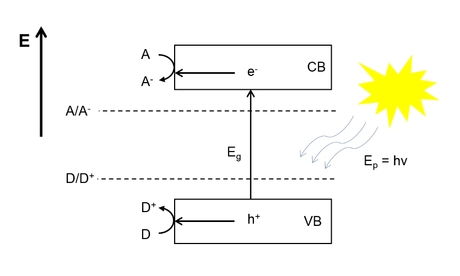Long live the charge carriers!
In photocatalysis, a semiconductor is illuminated by an external light source (e.g. the sun). Provided that the photon energy is larger than the band gap energy, electrons can get excited from the valence band to the conduction band, leaving an electron vacancy (i.e. a hole) in the first band (Figure 1). The excited electrons and holes (also known as charge carriers) can be used for reduction and oxidation reactions, respectively, provided that the edges of the conduction band and the valence band are at favorable positions compared to the redox potentials. Optimally, all generated electrons and holes are used for photocatalytic reactions. Practically, however, only a percentage of the generated charge carriers is used for photocatalysis, as the other charge carriers recombine with each other. Therefore, suppression of electron/hole recombination is important for achieving efficient photocatalysis.
In this project, we collaborate with the Optics group of Prof. Dr. Georg Woltersdorf to study the transient behavior of electrons and holes in different photocatalytic samples in order to gain more insight into their recombination behavior and the lifetime of the generated charge carriers. To this end, we use a technique called femtosecond transient absorption spectroscopy (fs-TAS) (Figure 2). This technique is based on the fact that the absorption spectrum of a photocatalytic material slightly changes when it is in an excited state. Considering (I) that the magnitude of this change is dependent on the amount of electron-hole pairs present and (II) that these pairs recombine over time, one can monitor the lifetime of those charge carriers by determining the change in absorption spectrum over time after briefly exciting the photocatalyst.
Our goal in this project is not only to determine the lifetime of the generated charge carriers in a specific sample, but also to use this information in order to alter our future samples in such a way that the lifetime of the as-generated charge carriers is enhanced.
References
[1] K. Wenderich; PhD thesis: Photodeposition of platinum nanoparticles on well-defined tungsten oxide; Enschede, 2016
[2] F. Kanal; PhD thesis: Femtosecond Transient Absorption Spectroscopy – Technical Improvements and Applications to Ultrafast Molecular Phenomena; Würzburg, 2015






